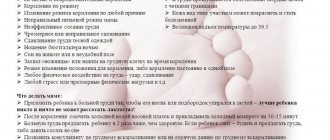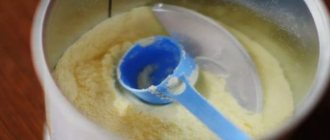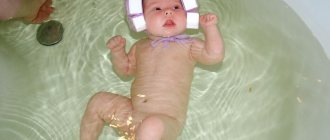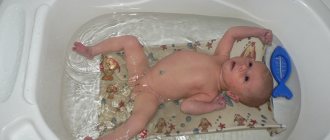Choosing the right mixture
Formulas are created to provide the child with all the necessary nutrients if breastfeeding is not possible. Most formulas are made from cow's milk, and all popular brands tend to have similar compositions. Unless your doctor recommends a specific formula, choose one that is fortified with iron.
Based on the type of preparation, mixtures are divided into three types:
- Ready-to-eat (most expensive)
- Liquid concentrate (cheaper)
- Powder (the most economical)
Read the instructions carefully before mixing.
Cautions when feeding formula from a bottle
During artificial feeding, it is important to constantly monitor the baby's condition.
When the baby eats food, the mother must:
- Monitor the position of the child's head. The baby should not eat while completely lying down. The newborn's head needs to be raised slightly by placing a diaper or a special pillow for infants under it. The location on the back allows the mixture to enter the middle ear area.
- Take breaks during feeding. Every 5-10 minutes, it is necessary to remove the pacifier and give the baby the opportunity to release the air accumulated in the stomach to prevent bloating and colic.
- Make sure the nipple is completely filled with milk. Air accumulates in an empty nipple, causing problems with the gastrointestinal tract if it enters the baby's body.
- Lift the child vertically, thereby helping to regurgitate excess food and air after each feeding.
- Control the flow of milk. For newborns, only very slow feeding is allowed. If the nipple or bottle is damaged, it must be replaced immediately.
The mixture is considered correctly selected if the newborn does not have:
- constant crying;
- frequent pain in the stomach (the child reports intestinal problems by bringing his legs to his tummy);
- sleep disorders;
- lethargy;
- appearance of skin rashes
- problems with stool (in particular, white spots in the stool indicating that some of the food is not digested).
If these symptoms occur, the young mother should contact a pediatrician to replace the diet with a hypoallergenic one.
Required volume
The stomach of a newborn baby can initially hold very little food. At first, 30–60 ml per feeding is enough, but by the time the baby is two months old, he will need 700–940 ml per day and 6–7 meals per day.
Here is an approximate calculation of the amount of formula per feeding for a baby:
| Age: | Amount of formula per feeding: | Feeding frequency: |
| Newborn | 60–90 ml | Every 3–4 hours |
| One month | 120 ml | Every 4 hours |
| Two month | 120 ml | 6–7 feedings per day |
| Four months | 120–180 ml | 6 feedings per day |
| Six months | 180–240 ml | 5 feedings per day |
| One year | 240 ml | 2–3 feedings per day plus baby food |
Recommendations for the mother when feeding formula from a bottle
Your pediatrician will tell you how to properly bottle-feed your newborn during a mandatory examination.
When carrying out artificial feeding, you must adhere to certain rules:
- Bottles and nipples, before and after feeding, should be washed with warm running water and sterilized for at least 2 minutes. Baby feeding utensils should be cleaned with special detergents (the use of ordinary dishwashing liquid is not allowed). If the bottle is damaged or changes color, it is replaced with a new one.
- The feeding formula is selected strictly in accordance with the age and preference of the child. When purchasing food, special attention should be paid to the composition of the product, checking the presence of minerals, vitamins, pro- and prebiotics, and nucleotides in it.
- The suspension should be prepared only in accordance with the instructions. Water for diluting the powder should not be hotter than 20-30 degrees. The finished mixture is shaken well. Before feeding, you need to check the temperature of the prepared solution by dropping it on your wrist.
- Before feeding, be sure to check the integrity of the nipple and the flow rate at which food is supplied. Ideally, the holes should be located just below the top. Newborns can only be fed with a nipple with a minimum number of holes (category “0+”).
- An infant should eat no more than 9 times a day (the approximate interval between feedings for artificial infants is 3 hours) of 100 ml. There is no need to additionally feed the baby.
- After eating, the little person needs to be held upright for 5-15 minutes to regurgitate the excess mixture and release the trapped air.
- Children who are bottle-fed should be given additional water. Liquids can be given 20 minutes after meals.
The new mixture is introduced into feeding gradually:
- In the first 2 days, 50-70 grams are given. diluted powder. The required volume of fluid is replenished with boiled water or special tea for newborns.
- In the absence of allergic reactions and intestinal problems, the volume of food gradually increases over the course of a week (up to the prescribed 100 grams).
The baby’s body adapts to the new diet in 2-3 weeks.
What you should know:
- Hand washing
Always wash your hands thoroughly before preparing the mixture.
- Cleaning feeding equipment
If you rinse bottles and teats well with clean, hot water, there is no need to boil or sterilize them. Completely remove all remaining mixture. Unwashed food particles can spoil and cause digestive upset in your baby.
- Should I throw away unused diluted mixture?
If your baby has not fed from a bottle, the prepared formula can be stored in the refrigerator for up to 48 hours. After he has touched the pacifier even once, throw away everything that is left.
- Warming up the mixture
Never heat the mixture in the microwave! Microwave ovens heat mixtures unevenly, and a child can get burned by the hot mixture. Run the bottle under hot water for a few minutes to warm it to room temperature.
- Replacing the mixture
Sometimes, in order to cope with your baby's digestive problems, it is necessary to replace the formula. Switching to soy mixtures helps get rid of allergies, but first you need to consult a doctor.
- Changes in meal schedule
Formula takes a little longer to digest in the intestines than breast milk, so the time between feedings may be longer (three to four hours) and the stool may be slightly dryer and larger in size.
How to feed
It often happens that young mothers do not know how to properly feed their newborn with formula from a bottle. As a result, during direct manipulation, women face various problems. The latter include colic, frequent regurgitation, poor digestibility of food and, as a result, weight loss. To avoid such phenomena, you need to water your baby correctly.
Preparing for feeding
Before you bottle feed your baby, you need to prepare for the process. The first stage of preparation includes choosing a mixture and a feeding container.
Interesting. For the first time, the baby is given the mixture in the maternity hospital 2-3 hours after birth. At first, the baby’s unprepared stomach gets used to an unfamiliar product; often parents have to go through many options to find the optimal one.
Manufacturers of mixtures offer the following types of product:
- Dairy. The most common option, intended for healthy full-term babies. The main condition is that the child must digest lactose normally. In this case, the choice of a specific product is very wide, and each of them may differ in composition.
- Lactose-free. If the newborn’s body is not able to digest lactose, this substance should not be ingested with food.
- With probiotics. This product improves the functioning of the gastrointestinal tract. Almost all dry formulas contain a probiotic.
- Hypoallergenic. Sometimes infants have allergic reactions to certain foods. This is explained by the special sensitivity of the digestive system of a young body. In this case, the child requires specialized nutrition.
As for choosing a bottle, when purchasing it, it is important to consider the shape, size of the container and the material from which it is made. The most common option is a container made of high-quality plastic (glass vessels are now very rare).
On a note. Plastic containers have many advantages, but their main disadvantage is the release of harmful substances when heated. Therefore, it is extremely undesirable to expose containers to such influences.
Modern manufacturers do not stop in the process of improving their products. To simplify the feeding process and also prevent the occurrence of colic, bottles are offered that are equipped with a special valve that prevents the swallowing of air during sucking.
Infant formula
Important! The bottle must be kept clean, otherwise the infant’s fragile body may suffer from viral and bacterial infections.
Preparing for feeding includes several main steps, namely:
- Disinfection. The container must be washed thoroughly using a special cleaning agent. If the bottle is made of glass, it can be immersed in boiling water for a short time (1 minute is enough).
- Water. It needs to be boiled and then cooled a little. It is recommended to use filtered water.
- Breeding. This process is carried out according to the instructions indicated on the packaging (it indicates how much mixture should be taken and in what quantity to dilute it with water). It is necessary to strictly observe the proportions, since this directly affects the quality of digestion. To prepare the mixture, take a few spoons of powder (most often 1 measuring spoon per 30 ml of water), dilute with water, mix thoroughly (it is important that there are no lumps left).
- Selecting the right temperature. It is not recommended to dilute the composition with boiling water, since under the influence of high temperatures the product loses its beneficial properties. Milk that is too hot needs to be cooled, milk that is too cold needs to be warmed up a little. To check the temperature, drop a small amount of the mixture onto the back of your palm. If the milk is warm, then you can drink it.
Important! Before starting to prepare the mixture, as well as immediately before feeding, you must wash your hands with soap.
Bottle with measuring division
Establishing a bond during feeding
Young mothers who are forced to replace breastfeeding with artificial feeding often worry about establishing an emotional connection with their child in the first months of his life.
According to experts, the exclusivity of psychological intimacy during breastfeeding is clearly exaggerated. Tactile contact is important regardless of the type of food. If a mother takes the baby in her arms, hugs him, presses him to herself, says kind words, strokes his back and head, exactly the same emotional closeness arises as with breastfeeding.
Recommendation. To strengthen the emotional connection with your baby during lactation, you need to look him straight in the eye. Thanks to the establishment of close contact, the baby will look forward to the next “meal” not only to satisfy hunger, but also to spend time with a loving mother in an atmosphere of care, affection and warmth.
Bottle feeding technique
The IV process has a number of features and nuances that must be taken into account when feeding a baby from a bottle:
- Comfortable location for mother and child. During lactation, a woman takes the baby into her arms. For greater comfort, you can place special pillows under your elbow. The issue of comfort is especially important because the feeding process lasts quite a long time.
- The child's head should be slightly raised and the correct position should be monitored all the time.
- The container is tilted at a slight angle to make it easier for the baby to drink. The angle may change depending on whether the baby has time to swallow food (if not, the mother moves her hand, if so, then vice versa).
- It is not necessary that the entire nipple be in the baby's mouth during lactation. It is enough for the baby to grab only its oblong part; the rest of the surface should have lips.
- You need to make sure that the oblong part of the nipple is filled with milk mixture. Otherwise, the child will swallow air along with food.
- You should not rush your baby - he should drink at a comfortable pace. If the child has finished his “meal”, he should not be forced to finish the remaining formula.
- From time to time you should check the condition of the pacifier. If it is deformed, then it can no longer be used.
- Before feeding, do not screw the lid too tightly, otherwise air will not penetrate into the nipple. As a result, a vacuum will form inside the bottle and the nipple will flatten. In this case, it will be difficult for the baby to draw out milk, he will quickly get tired and refuse the nipple. Therefore, after twisting the bottle, you need to slightly release the ring so that small bubbles are observed in it during lactation.
With IV, it is important to follow feeding technique
Breaks during lactation
The procedure for bottle feeding a newborn requires breaks during meals. During lactation, air sometimes enters the baby's esophagus, causing the baby to have a false feeling of fullness. For this reason, the baby needs to be given time and the opportunity to burp air. As a result, the child will regain his natural feeling of hunger, and he will continue to drink milk with appetite.
In order for the baby to burp, you need to hold him in an upright position or put him on your shoulder, placing the baby's arms on your back. This position promotes light pressure on the baby’s abdomen and thereby promotes the release of air to the outside.
It is also recommended to give the baby a back massage or lightly pat the child on it. It is necessary to gently press on the baby’s back by tapping the palm or stroking it. Patting should be confident and rhythmic.
Another effective way to make your baby burp is to place him on your lap. In all cases, it is recommended to place a towel to avoid contamination of clothing. Belching should be induced every 60-90 ml of the formula drunk (or more often if the newborn is fidgeting and fidgeting).
After 2-3 minutes, you can return to feeding even if the baby does not burp air. If the baby does not show interest in food, but starts to fuss, you can try again to provoke a burp or check the condition of the diaper. If the baby behaves calmly and looks happy, then most likely he is not hungry and has already finished his “meal”.
Psychological state of the nursing mother
It is very important that the adult who is doing the feeding is in a good mood, calm and relaxed. Kids are sensitive to the mood of mom and dad, adopt it and begin to behave in the same way. A tense, depressed, irritated state of an adult is absolutely not suitable for such an activity as feeding a baby. You need to try to relax, distract yourself from negative thoughts at least for the duration of feeding, then the baby will feel comfortable.
Things to Remember
- Always hold your baby firmly in your arms while he or she eats.
Try not to disturb or move your baby while feeding, otherwise he may choke.
- Check diapers
If your child pees less than usual, you should consult a doctor. This may indicate dehydration or lack of nutrition.
- Make sure the nipple hole is the right size
When it is too wide, the baby will choke and cannot keep up with the rapid flow of milk. If your baby is tense and trying too hard, the hole is probably too small and the nipple is too hard. Correct the situation, since it is difficult for the baby to get food, he may get tired and remain hungry.
Signs of proper bottle feeding
Whether a newborn is bottle-fed correctly becomes clear after observing the baby’s condition and behavior.
A child who receives a sufficient amount of nutrition selected specifically for him:
- feels good, cries little.
- sleeps calmly and for a long time;
- does not suffer from frequent regurgitation, diarrhea, or vomiting.
- eats with appetite, without refusing food;
- has clear skin without redness and allergic reactions;
- rarely suffers from stomach colic (no more than once every 3 days);
- empties the intestines 1-3 times a day (most often during feeding);
- is developing well and gaining weight.
The dangers of improper bottle feeding
The consequences of improper feeding are manifested in the behavior of the newborn. Malnutrition or overeating is dangerous for an infant by disrupting the development and condition of internal organs. These pathologies can be easily identified by observing characteristic signs.
| Malnutrition | Binge eating |
| The baby is very weak and inactive | The child spits up often and a lot, vomiting for no reason |
| Sleep disturbances and problems falling asleep | |
| The process of eating is accompanied by whims and crying | Increased gas formation, flatulence |
| In between feedings, the baby sucks a finger, a diaper | While eating, the newborn often raises his legs towards his stomach and grunts |
| There is a small amount of stool and urine in the diaper | The baby is naughty a lot, throws the pacifier, refuses to eat |
| There is a lack of weight | The child's weight exceeds the norm |
These signs indicate an incorrect regimen and dosage of baby food. Symptoms require parents to carefully study the instructions for infant formula and change the established proportions.
Poor nutritional choices are indicated by:
- severe diathesis;
- constant regurgitation;
- loose stools with white spots;
- stomach ache.
If these symptoms appear, the mixture is urgently changed to a similar product from another manufacturer.
Bottle feeding a newborn is an alternative option for feeding a child if lactation is impossible. The correctness of the process depends on the mixture chosen by the parents, the equipment and the position taken by the baby while eating.
Article design: Vladimir the Great











